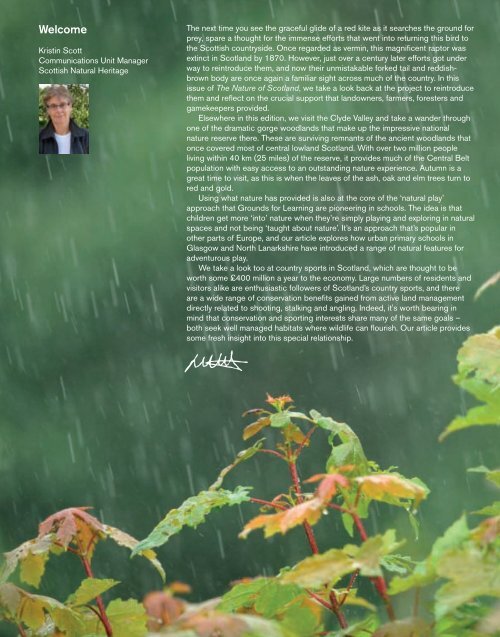The Nature of Scotland â Autumn 2011 â Issue 13
The Nature of Scotland â Autumn 2011 â Issue 13
The Nature of Scotland â Autumn 2011 â Issue 13
You also want an ePaper? Increase the reach of your titles
YUMPU automatically turns print PDFs into web optimized ePapers that Google loves.
Welcome<br />
Kristin Scott<br />
Communications Unit Manager<br />
Scottish Natural Heritage<br />
<strong>The</strong> next time you see the graceful glide <strong>of</strong> a red kite as it searches the ground for<br />
prey, spare a thought for the immense efforts that went into returning this bird to<br />
the Scottish countryside. Once regarded as vermin, this magnificent raptor was<br />
extinct in <strong>Scotland</strong> by 1870. However, just over a century later efforts got under<br />
way to reintroduce them, and now their unmistakable forked tail and reddishbrown<br />
body are once again a familiar sight across much <strong>of</strong> the country. In this<br />
issue <strong>of</strong> <strong>The</strong> <strong>Nature</strong> <strong>of</strong> <strong>Scotland</strong>, we take a look back at the project to reintroduce<br />
them and reflect on the crucial support that landowners, farmers, foresters and<br />
gamekeepers provided.<br />
Elsewhere in this edition, we visit the Clyde Valley and take a wander through<br />
one <strong>of</strong> the dramatic gorge woodlands that make up the impressive national<br />
nature reserve there. <strong>The</strong>se are surviving remnants <strong>of</strong> the ancient woodlands that<br />
once covered most <strong>of</strong> central lowland <strong>Scotland</strong>. With over two million people<br />
living within 40 km (25 miles) <strong>of</strong> the reserve, it provides much <strong>of</strong> the Central Belt<br />
population with easy access to an outstanding nature experience. <strong>Autumn</strong> is a<br />
great time to visit, as this is when the leaves <strong>of</strong> the ash, oak and elm trees turn to<br />
red and gold.<br />
Using what nature has provided is also at the core <strong>of</strong> the ‘natural play’<br />
approach that Grounds for Learning are pioneering in schools. <strong>The</strong> idea is that<br />
children get more ‘into’ nature when they’re simply playing and exploring in natural<br />
spaces and not being ‘taught about nature’. It’s an approach that’s popular in<br />
other parts <strong>of</strong> Europe, and our article explores how urban primary schools in<br />
Glasgow and North Lanarkshire have introduced a range <strong>of</strong> natural features for<br />
adventurous play.<br />
We take a look too at country sports in <strong>Scotland</strong>, which are thought to be<br />
worth some £400 million a year to the economy. Large numbers <strong>of</strong> residents and<br />
visitors alike are enthusiastic followers <strong>of</strong> <strong>Scotland</strong>’s country sports, and there<br />
are a wide range <strong>of</strong> conservation benefits gained from active land management<br />
directly related to shooting, stalking and angling. Indeed, it's worth bearing in<br />
mind that conservation and sporting interests share many <strong>of</strong> the same goals –<br />
both seek well managed habitats where wildlife can flourish. Our article provides<br />
some fresh insight into this special relationship.<br />
www.snh.gov.uk<br />
3

















